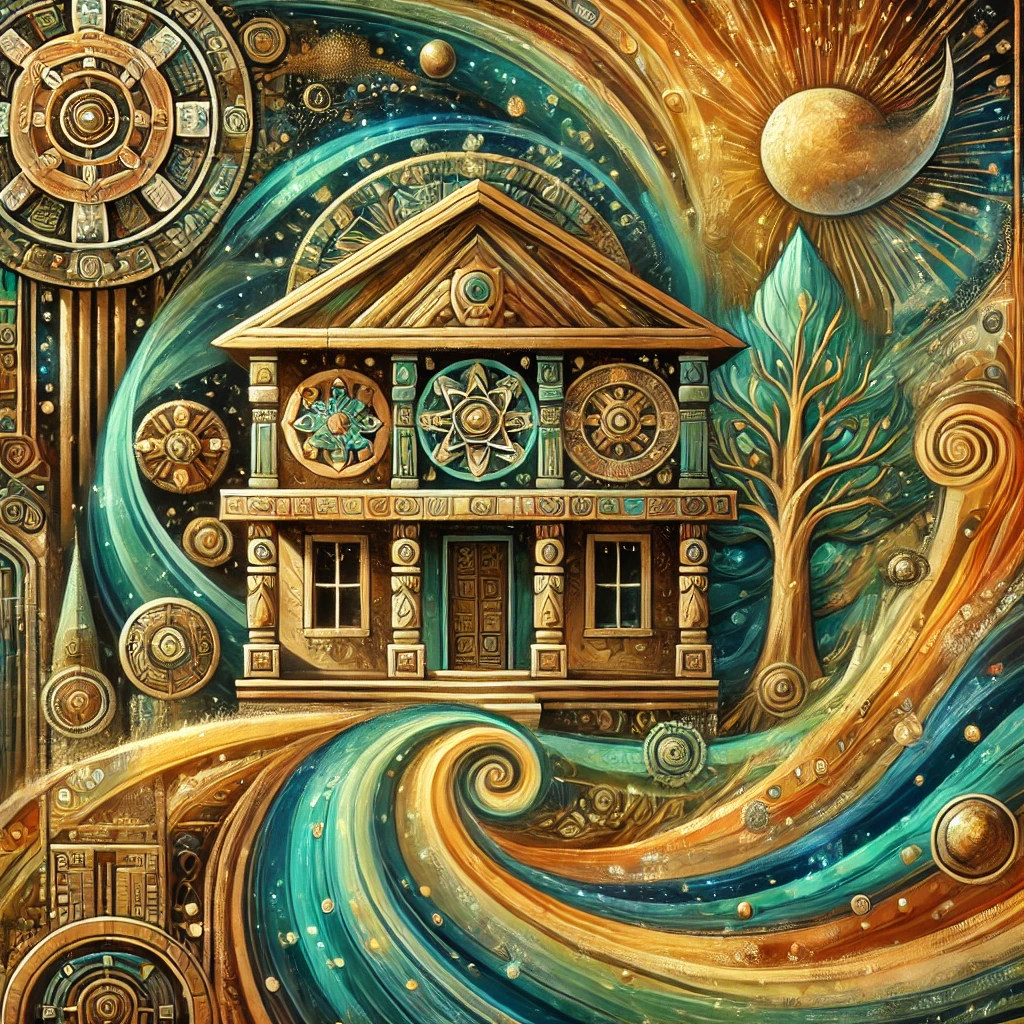Maya Cosmology

Place of Origin: Mesoamerica (modern-day Mexico, Guatemala, Belize, Honduras, and El Salvador)
Century of Origin: Pre-Columbian Era (1st Millennium BCE)
Overview of Maya Cosmology
Maya Cosmology is the complex and deeply spiritual worldview of the ancient Maya civilisation. It encompasses ideas about the origins of the universe, the cycles of time, and humanity’s role in maintaining cosmic balance. Central to this philosophy is the belief that all aspects of life—nature, humans, and the divine—are interconnected. The Maya believed that their actions directly impacted the harmony of the cosmos, and they expressed these ideas through rituals, art, and their advanced understanding of astronomy.
In Maya metaphysics, the universe is structured into three main realms: the heavens, the earthly world, and the underworld (Xibalba). These realms are connected by the World Tree, a sacred symbol representing life and the unity of all existence. The heavens were home to celestial gods, the earthly world was the domain of humans and nature, and the underworld was a place of transformation and renewal. Time was perceived as cyclical, with recurring ages of creation and destruction, each governed by divine powers.
The Maya acquired knowledge through careful observation of the natural world, especially celestial movements. Their advanced astronomical systems and calendars, such as the Long Count and the Tzolk’in, helped them track time, predict events, and align their lives with cosmic cycles. Sacred texts like the Popol Vuh contained myths and moral teachings that provided spiritual guidance. The Maya also valued experiential knowledge gained through rituals, ceremonies, and dream interpretation.
Ethical living in Maya Cosmology was about maintaining balance and harmony with the natural and spiritual worlds. The Maya believed that humans had a sacred duty to respect the earth, honour the gods, and uphold communal responsibilities. Acts of greed, dishonesty, or neglect were seen as disruptive to cosmic order. Rituals, offerings, and ceremonies were ways to restore harmony and show gratitude to the gods.
The logic of Maya Cosmology was rooted in recognising and respecting natural cycles and patterns. Decisions were guided by the belief that every action has a consequence, not only for individuals but for the community and the cosmos. Rituals were performed to align human actions with cosmic forces, ensuring stability in a world seen as dynamic and interconnected. This logic also extended to their mathematics, which used a vigesimal (base-20) system to model cosmic principles.
In Maya thought, aesthetics were deeply tied to spirituality and cosmic harmony. Art, architecture, and music were seen as expressions of the divine. Temples and pyramids were built to align with celestial events, such as solstices and equinoxes, and adorned with intricate carvings that depicted gods, myths, and the cosmos. Music and dance were integral to rituals, serving to connect humans with the divine and celebrate the cycles of life.
The Maya used a combination of scientific observation, spiritual practice, and storytelling to explore philosophical questions. Priests and astronomers studied celestial movements and natural cycles, while rituals and ceremonies allowed for spiritual connection and reflection. Sacred narratives like the Popol Vuh provided a framework for understanding the world, blending mythology with ethical guidance. This methodology was holistic, integrating intellect, spirituality, and community.
Humans, in Maya Cosmology, were seen as sacred beings deeply connected to nature and the divine. According to the Popol Vuh, humans were created from maize, the most important crop for the Maya, symbolising their reliance on and gratitude toward the earth. Life was a gift from the gods, and humans were expected to honour this gift by living ethically, performing rituals, and working for the well-being of the community. Humanity’s role was to maintain the balance between the realms of existence.
Maya rulers were not just political leaders; they were spiritual intermediaries between the gods and the people. They were responsible for performing rituals, building temples, and ensuring the prosperity of their kingdoms. Leadership was seen as a divine duty, and rulers were expected to align their actions with cosmic principles. Their legitimacy often depended on their ability to interpret celestial events and maintain harmony in their territories.
Maya Cosmology developed over millennia, with its roots in earlier Mesoamerican traditions. It flourished during the Classic Period (250-900 CE), a time of great achievements in astronomy, mathematics, and architecture. The Popol Vuh, written during the Postclassic Period, captures many of these philosophical ideas. Despite the decline of the ancient Maya civilisation, elements of their cosmology survive in modern Maya communities, blending with new cultural and religious influences.
Key themes include the interconnectedness of all life, the cyclical nature of time, the sacred balance of the universe, and the role of humans in maintaining harmony. The Maya emphasised gratitude, respect for nature, and the importance of rituals as tools for aligning with cosmic forces. Their philosophy continues to inspire reflections on sustainability, spirituality, and the rhythms of life.
Maya Cosmology does not attribute its teachings to individual philosophers but to collective wisdom passed down through priests, astronomers, and storytellers. The Popol Vuh is one of the most important texts, offering a glimpse into the philosophical and spiritual insights of the Maya. Modern Maya spiritual leaders continue to preserve and adapt these traditions.



